tow MERCEDES-BENZ C-CLASS SALOON 2018 Manual Online
[x] Cancel search | Manufacturer: MERCEDES-BENZ, Model Year: 2018, Model line: C-CLASS SALOON, Model: MERCEDES-BENZ C-CLASS SALOON 2018Pages: 609, PDF Size: 11.19 MB
Page 429 of 609
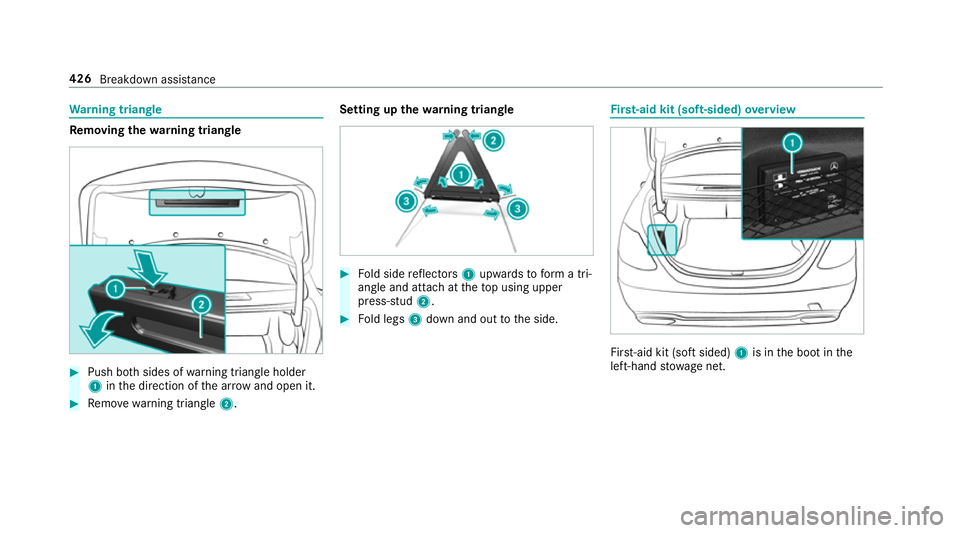
Wa
rning triangle Re
moving the warning triangle 0007
Push bo thsides of warning triangle holder
1 inthe direction of the ar row and open it. 0007
Remo ve wa rning triangle 2. Setting up
thewa rning triangle 0007
Fold side reflectors 1upwards toform a tri‐
angle and attach at theto p using upper
press-stud 2. 0007
Fold legs 3down and out tothe side. Fi
rs t-aid kit (soft-sided) overview Fir
st-aid kit (so ftsided) 1is in the boot in the
left-hand stowage net. 426
Breakdown assis tance
Page 435 of 609
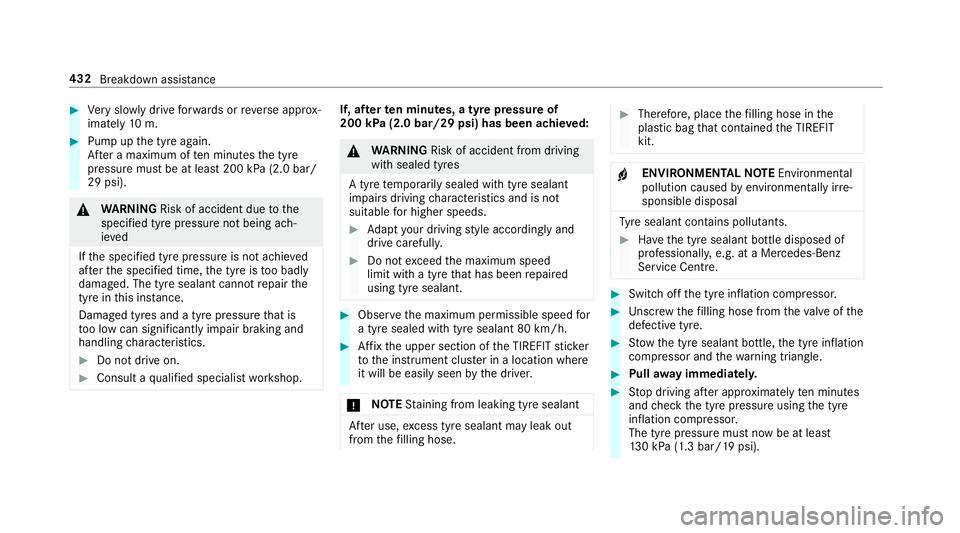
0007
Very slowly drive forw ards or reve rse appr ox‐
imately 10m. 0007
Pump up the tyre again.
Af ter a maximum of ten minu testh e tyre
pressure must be at least 200 kPa (2.0 bar/
29 psi). 000A
WARNING Risk of accident due tothe
specified tyre pressure not being ach‐
ie ved
If th e specified tyre pressure is not achie ved
af te rth e specified time, the tyre is too badly
damaged. The tyre sealant cannot repair the
tyre in this ins tance.
Dama ged tyres and a tyre pressure that is
to o low can significantly impair braking and
handling characteristics. 0007
Do not drive on. 0007
Consult a qualified specialist workshop. If, af
terte n minutes, a tyre pressure of
200 kPa (2.0 bar/29 psi) has been achie ved: 000A
WARNING Risk of accident from driving
wi th sealed tyres
A tyre temp orarily sealed with tyre sealant
impairs driving characteristics and is not
suitable for higher speeds. 0007
Adapt your driving style according lyand
drive carefull y. 0007
Do not exceed the maximum speed
limit with a tyre that has been repaired
using tyre sealant. 0007
Obser vethe maximum permissible speed for
a tyre sealed with tyre sealant 80 km/h. 0007
Affix th e upper section of the TIREFIT sticker
to the instrument clus ter in a location where
it will be easi lyseen bythe driver.
000E NO
TEStaining from leaking tyre sealant Af
ter use, excess tyre sealant may leak out
from thefilling hose. 0007
Therefore, place thefilling hose in the
plastic bag that con tained the TIREFIT
kit. 000F
ENVIRONMEN
TALNO TEEnvironmental
pollution caused byenvironmen tally ir re‐
sponsible disposal Ty
re sealant contains polluta nts. 0007
Have the tyre sealant bottle disposed of
professionall y,e.g. at a Mercedes-Benz
Service Centre. 0007
Switch off the tyre inflation compressor. 0007
Unscr ew thefilling hose from theva lve of the
defective tyre. 0007
Stow th e tyre sealant bottle, the tyre inflation
compressor and thewa rning triangle. 0007
Pull away immediatel y. 0007
Stop driving af ter appro ximately ten minu tes
and check the tyre pressure using the tyre
inflation compressor.
The tyre pressure must now be at least
13 0 kPa (1.3 bar/19 psi). 432
Breakd own assi stance
Page 442 of 609

each time with
the conta cts onyour own
ve hicle firs t. 0007
Afterre moving the jump lead/charging
cable, close co ver2 of positive clamp 3. 0007
Close co ver1.
Fu rther information can be obtained at a quali‐
fi ed specialist workshop. Re
placing the 12V battery 0007
Obser vethe no tes on the12 V battery
(0013 page 434).
Mercedes-Benz recommends that you ha vethe
12 V battery replaced at a qualified specialist
wo rkshop, e.g. at a Mercedes-Benz Service
Centre.
Obser vethefo llowing no tes if youwa ntto
re place the battery yourself:
R Alw aysre place a faulty bat tery with a battery
which meets the specific vehicle requ ire‐
ments. The
vehicle is equipped with an AGMtech nol‐
ogy battery (Absorbent Glass Mat) or a li th‐
ium-ion batter y.Fu llve hicle functionality is
only guaranteed with an AGM battery or lith‐
ium-ion batter y.Fo r saf etyre asons,
Mercedes-Benz recommends that you on ly
use bat teries which ha vebeen tested and
appr oved foryo ur vehicle byMercedes-Benz.
R Carryover de tachable parts, such as vent
hoses, elbow fittings or term inal co vers from
th e battery being replaced.
R Make sure that theve nt hose is al ways con‐
nected tothe original opening on the side of
th e batter y.
Fit any existing or supplied cell caps.
Otherwise, gases or battery acid could
escape.
R Make sure that de tach able parts are recon‐
nected in the same way. To
w- starting or towing away Pe
rm itted towing me thods Plug-in
hybrid: be sure toobser vethe no tes in
th e Supplement. Otherwise, you may failto rec‐
ognise dangers.
Mercedes-Benz recommends transporting your
ve hicle in the case of a breakdown, rath er than
to wing it away.
Fo rto wing, use a tow rope or tow bar with bo th
axles on the ground. Do not use tow bar sys‐
te ms.
000E NO
TEDama getotheve hicle due to tow‐
ing away incor rectly 0007
Obser vethe instructions and no tes on
to wing away. Breakdown assis
tance 439
Page 443 of 609
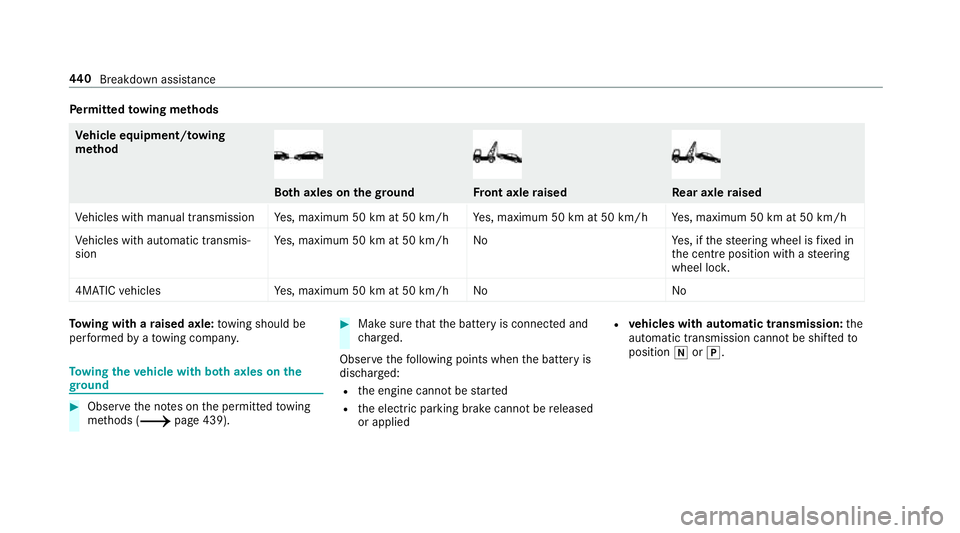
Pe
rm itted towing me thods Ve
hicle equipment/ towing
me thod Bo
th axles on thegr ound Fr
ont axle raised Re
ar axle raised
Ve hicles with manual transmission Yes, maximum 50 km at 50 km/h Yes, maximum 50 km at 50 km/h Yes, maximum 50 km at 50 km/h
Ve hicles with automatic transmis‐
sion Ye
s, maximum 50 km at 50 km/h No Yes, if thesteering wheel is fixe d in
th e cent reposition with a steering
wheel loc k.
4MATIC vehicles Yes, maximum 50 km at 50 km/h No NoTo
wing with a raised axle: towing should be
per form ed byato wing compan y. To
wing theve hicle with bo thaxles on the
gr ound 0007
Obser vethe no tes on the permitted towing
me thods (0013 page 439). 0007
Make sure that the battery is connected and
ch arge d.
Obser vethefo llowing points when the battery is
dischar ged:
R the engine cann otbe star ted
R the electric parking brake cann otbe released
or applied R
vehicles with automatic transmission: the
automatic transmission cannot be shif tedto
position 005Cor005D. 440
Breakdown assis tance
Page 444 of 609

0009
Vehicles with automatic transmission: if
th e automatic transmission cann otbe shif‐
te dto position 005C, orthe multifunction dis‐
play in the instrument clus ter does not show
anything, ha vetheve hicle transpor tedaw ay
( 0013 page442). A towing vehicle with lift‐
ing equipment is requ ired forve hicle trans‐
por tation.
000E NO
TEDama gedue to to wing away at
ex cessively high speeds or over long dis‐
ta nces The driv
etra in could be damaged when tow‐
ing at excessively high speeds or over long
dis tances. 0007
Atowing speed of 50 km/h must not
be exc eeded. 0007
Atowing dis tance of 50 km must not be
exc eeded. 000A
WARNING Risk of accident when towing
a ve hicle which is too heavy
If th eve hicle being tow- star ted or towed
aw ay is heavier than the permissible gross
mass, thefo llowing situations can occur:
R theto wing eye may become de tach ed.
R the car/t railer combination may swer ve
or eve nove rturn. 0007
If ano ther vehicle is tow- star ted or
to we daw ay, its weight must not exceed
th e permissible gross mass of your own
ve hicle. If a
vehicle must be tow star ted or towe daw ay,
its permissible gross mass must not exceed the
permissible gross mass of theto wing vehicle. 0007
Information on the permissible gross mass of
th eve hicle can be found on theve hicle iden‐
tification plate (0013 page473). 0007
Vehicles with automatic transmission: do
not open the driver's door or front passenger
door, otherwise the automatic transmission
automatically shifts toposition 005D. 0007
Fittheto wing eye (0013 page444). 0007
Fasten theto w bar.
000E NO
TEDama gedue toincor rect connec‐
tion 0007
Only connect theto w rope or tow bar to
th eto wing eyes. 0007
Deactivate the automatic locking mechanism
(0013 page81). 0007
Do not activate the HOLD function. 0007
Deactivate tow- aw ay protection
(0013 page 99). 0007
Deactivate Active Brake Assi st
( 0013 page214). 0007
Vehicles with automatic transmission:
shift the automatic transmission toposition
005C. 0007
Vehicles with manual transmission: shift
to neutral 005C. 0007
Release the electric parking brake. Breakdown assis
tance 441
Page 445 of 609
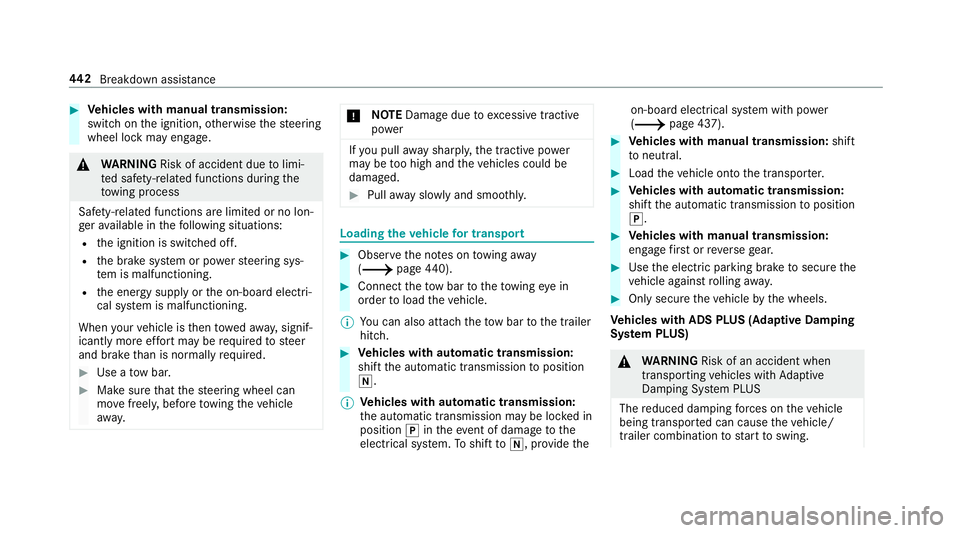
0007
Vehicles with manual transmission:
switch on the ignition, otherwise thesteering
wheel lock may engage. 000A
WARNING Risk of accident due tolimi‐
te d saf ety-re lated functions during the
to wing process
Saf ety-re lated functions are limited or no lon‐
ge rav ailable in thefo llowing situations:
R the ignition is switched off.
R the brake sy stem or po werst eering sys‐
te m is malfunctioning.
R the energy supply or the on-board electri‐
cal sy stem is malfunctioning.
When your vehicle is then towe daw ay, signif‐
icantly more ef fort may be requ ired tosteer
and brake than is no rmally requ ired. 0007
Use a tow bar. 0007
Make sure that thesteering wheel can
mo vefreely, before towing theve hicle
aw ay. 000E
NO
TEDama gedue toexcessive tracti ve
po wer If
yo u pull away sharpl y,the tractive po wer
may be too high and theve hicles could be
damaged. 0007
Pull away slowly and smoo thly. Loading the
vehicle for transport 0007
Obser vethe no tes on towing away
( 0013 page440). 0007
Connect theto w bar totheto wing eye in
order toload theve hicle.
0009 You can also attach theto w bar tothe trailer
hitch. 0007
Vehicles with automatic transmission:
shift the automatic transmission toposition
005C.
0009 Ve
hicles with automatic transmission:
th e automatic transmission may be loc ked in
position 005Dintheeve nt of dama getothe
electrical sy stem. Toshift to005C , pr ovide the on-board electrical sy
stem with po wer
( 0013 page 437). 0007
Vehicles with manual transmission: shift
to neutral. 0007
Load theve hicle onto the transpor ter. 0007
Vehicles with automatic transmission:
shift the automatic transmission toposition
005D. 0007
Vehicles with manual transmission:
engage firs t or reve rsege ar. 0007
Use the electric parking brake tosecure the
ve hicle against rolling away. 0007
Only secure theve hicle bythe wheels.
Ve hicles with ADS PLUS (Adaptive Damping
Sy stem PLUS) 000A
WARNING Risk of an accident when
transporting vehicles with Adaptive
Damping Sy stem PLUS
The reduced damping forc es on theve hicle
being transpor ted can cause theve hicle/
trailer combination tostart toswing. 442
Breakdown assis tance
Page 446 of 609

As a
result, when transporting vehicles with
th eAd aptive Damping Sy stem PLUS, the
ve hicle/trailer combination may start toskid.
Consequentl y,yo u could lose cont rol of your
ve hicle. 0007
When transporting, ensure that:
R theve hicle has been loaded onto
th e transpor ter cor rectly
R theve hicle is secured at all four
wheels with suitable tensioning
st ra ps
R the maximum permissible speed of
60 km/h is not exceeded when
transporting 000E
NO
TEDama getotheve hicle from secur‐
ing it incor rectly 0007
After loading, theve hicle must be
secured on all four wheels. Otherwise,
th eve hicle could be damaged. 0007
A minimum dis tance of 20 cm up wards
and 10cm down wards must be kept to
th e transport platform. 0007
Secure theve hicle on all four wheels af ter
loading.
4MATIC vehicles/ vehicles with automatic
transmission 0007
Make sure that the front and rear axles come
to rest on the same transpor tation vehicle.
000E NO
TEDama getothe driv etra in due to
incor rect positioning 0007
Do not position theve hicle abo vethe
connection point of the transport vehi‐
cle. To
wing eyesto rage location The
towing eye1 is located in thestow age
space under the boot floor. Breakdown assis
tance 443
Page 447 of 609
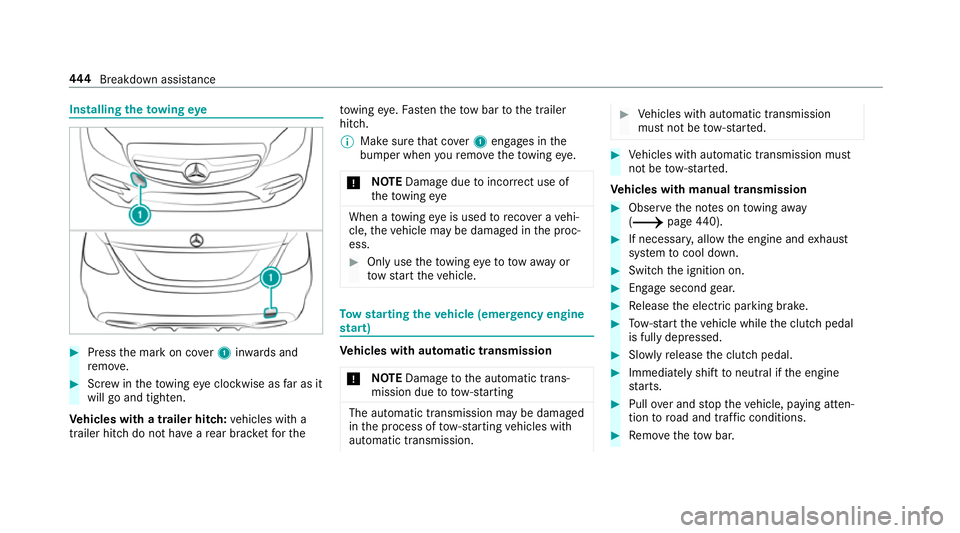
Installing
theto wing eye 0007
Press the mark on co ver1 inwa rds and
re mo ve. 0007
Screw intheto wing eyeclockwise as far as it
will go and tighten.
Ve hicles with a trailer hitch: vehicles with a
trailer hitch do not ha veare ar brac ketfo rthe to
wing eye. Fasten theto w bar tothe trailer
hitch.
0009 Make sure that co ver1 engages in the
bumper when youre mo vetheto wing eye.
000E NO
TEDama gedue toincor rect use of
th eto wing eye When a
towing eye is used toreco ver a vehi‐
cle, theve hicle may be damaged in the proc‐
ess. 0007
Only use theto wing eyeto to waw ay or
to w start theve hicle. To
w starting theve hicle (eme rgency engine
st art) Ve
hicles with automatic transmission
000E NO
TEDama getothe automatic trans‐
mission due to tow-starting The automatic transmission may be damaged
in the process of tow- starting vehicles with
automatic transmission. 0007
Vehicles with automatic transmission
must not be tow- star ted. 0007
Vehicles with automatic transmission must
not be tow- star ted.
Ve hicles with manual transmission 0007
Obser vethe no tes on towing away
( 0013 page440). 0007
If necessa ry, allow the engine and exhaust
sy stem tocool down. 0007
Switch the ignition on. 0007
Enga gesecond gear. 0007
Release the electric parking brake. 0007
Tow- start theve hicle while the clutch pedal
is fully depressed. 0007
Slowly release the clutch pedal. 0007
Immediately shift toneutral if the engine
st arts. 0007
Pull over and stop theve hicle, paying atten‐
tion toroad and traf fic conditions. 0007
Remo vetheto w bar. 444
Breakdown assis tance
Page 462 of 609

These tyres are specially adap
tedto the con‐
trol sy stems, such as ABS, ESP ®
and
4MATIC, and mar ked as follo ws:
R MO = Mercedes-Benz Original
R MOE = Mercedes-Benz Original Extended
(run-flat tyres only for cer tain wheels)
R MO1 = Mercedes-Benz Original (only cer‐
ta in AMG tyres)
Cer tain characteristics, such as handling,
ve hicle noise emissions, fuel consum ption,
et c. may otherwise be adversely af fected.
Fu rthermore, other tyre sizes could result in
th e tyres rubbing against the body and axle
components when loaded. This could result
in damage tothe tyre or theve hicle.
Only use tyres, wheels and accessories that
ha ve been checked and recommended by
Mercedes-Benz. 000E
NO
TERisk todriving saf ety from retrea‐
ded tyres Re
treaded tyres are nei ther tested nor rec‐
ommended byMercedes-Benz, since pr evi‐
ous damage cannot alw ays be de tected on
re treaded tyres.
Fo rth is reason driving saf ety cannot be guar‐
anteed. 0007
Do not use used tyres if you ha veno
information about their pr evious usage. 000E
NO
TEPossible damage towheels or
tyres when driving over obs tacles Lar
gewheels ha vea lo wer tyre section width.
The lo werth e tyre section width, the greater
is therisk of damage towheels or tyres when
driving over obs tacles. 0007
Avoid obs tacles or drive pa rticular ly
carefully. 000E
NO
TEDama getoelectronic component
parts from the use of tyre-fitting tools Ve
hicles with a tyre pressure monitoring
sy stem: electronic component parts are
located in the wheel. Tyre-fitting tools should
not be applied in the area of theva lve.
The tools could damage the electronic com‐
ponent parts. 0007
Have the tyres changed at a qualified
specialist workshop onl y. 000E
NO
TEDama getosummer tyres at low
ambient temp eratures At
low ambient temp eratures, tears could
fo rm when driving with summer tyres, caus‐
ing permanent damage tothe tyre. 0007
Attemp eratures below 7 °C, use M+S
tyres. Ac
cessory pa rts th at are not appr ovedfo ryo ur
ve hicle byMercedes-Benz or are not being used
cor rectly can impair the operating saf ety. Wheels and tyres
459
Page 472 of 609

Ve
hicles with a tyre pressure monitoring
sy stem: For a few minutes af ter an emer‐
ge ncy spa rewheel is fitted, the sy stem may
st ill display the tyre pressure of there mo ved
wheel.
Be sure toalso obse rveth efo llowing fur ther
re lated subjects:
R Notes on tyre pressure (0013 page449)
R Tyre pressure table (0013 page 450) Re
moving the eme rgency spa rewheel The eme
rgency spare wheel is secured in the
emer gency spa rewheel bag in the boot. 0007
Obser vethe information on mounting tyres
(0013 page 458). 0007
Open the boot. 0007
Detach thefast ening stra ps. 0007
Unhook there taining spring hooks of thefa s‐
te ning stra ps from the brac kets. 0007
Remo vethe emer gency spa rewheel bag with
th e emer gency spa rewheel. 0007
Open the emer gency spa rewheel bag and
re mo vethe emer gency spa rewheel. Collapsible spa
rewheel Inflating
the collapsible emer gency spare
wheel 000E
NO
TEDama getothe collapsible spare
wheel when lo wering theve hicle Lo
we ring theve hicle without pr eviously
inflating the collapsible spare wheel can
damage its rim. 0007
Inflate the collapsible spare wheel using
th e tyre inflation compressor before
lo we ring theve hicle. 000E
NO
TEOverheating due tothe tyre infla‐
tion compressor running too long 0007
Do not runth e tyre inflation compres‐
sor for longer than eight minutes with‐
out inter ruption. Re
quirements:
R Obser vethe manufacturer's saf ety no tes on
th e tyre inflation compressor label and on
th e tyre sealant bottle.
R Mount the collapsible emer gency spa re
wheel as desc ribed (0013 page 466).
The collapsible emer gency spa rewheel must
be moun ted before it is inflated.
R Remo vethe tyre inflation compressor from
th estow age space under the boot floor
(0013 page 429). Wheels and tyres
469